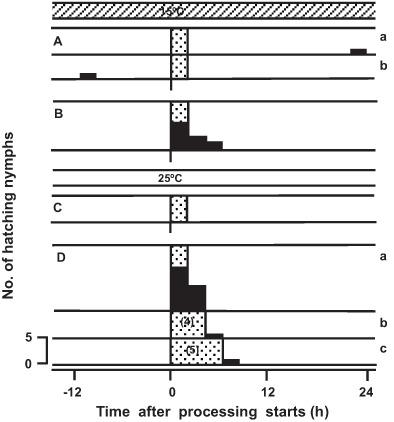当前位置:
X-MOL 学术
›
Entomol. Sci.
›
论文详情
Our official English website, www.x-mol.net, welcomes your feedback! (Note: you will need to create a separate account there.)
Effects of oxygen, carbon dioxide, and nitrogen on hatching behavior and hatching time in the katydid, Eobiana engelhardti subtropica Bey‐Bienko (Orthoptera: Tettigoniidae)
Entomological Science ( IF 0.9 ) Pub Date : 2020-12-07 , DOI: 10.1111/ens.12453 Tetsuo Arai 1
Entomological Science ( IF 0.9 ) Pub Date : 2020-12-07 , DOI: 10.1111/ens.12453 Tetsuo Arai 1
Affiliation

|
The trigger for the hatching behavior and determination of hatching time of the katydids, Eobiana engelhardti subtropica (Orthoptera: Tettigoniidae) have been shown to be influenced by light–dark signals or temperature. In this study, I investigated the effects of oxygen, carbon dioxide, and nitrogen on the hatching behavior and hatching time of the katydid. Eggs rarely hatched under a constant temperature of 25°C and hatched sporadically at a constant temperature of 15°C under continuous light in the air. However, when eggs were exposed to 100% oxygen or a mixture of oxygen and nitrogen (2:1 or 1:1), hatching occurred within a few seconds. Hatching behavior was directly triggered by high concentrations of oxygen. It was inhibited by exposure to 100% carbon dioxide, 100% nitrogen, or a mixture of oxygen and nitrogen (1:2). The hatching time, determined by the temperature fall (transfer from 25°C to 15°C), was delayed by these gases, and was reset by the transfer back of eggs to the air. This suggests the existence of a time‐measuring mechanism that is triggered by the transfer of eggs to the air. These results, indicating that hatching behavior was directly triggered by high concentrations of oxygen and that hatching time was set by the transfer from carbon dioxide or nitrogen to the air, are new findings to the best of my knowledge.
中文翻译:

氧,二氧化碳和氮对拟南芥Eobiana engelhardti subtropica Bey-Bienko(直翅目:T形纲)的孵化行为和孵化时间的影响
拟南芥Eobiana engelhardti subtropica的孵化行为的诱因和孵化时间的确定(直翅目:Tettigoniidae)已被明暗信号或温度影响。在这项研究中,我研究了氧气,二氧化碳和氮气对the的孵化行为和孵化时间的影响。鸡蛋很少会在25°C的恒温下孵化,而在持续不断的光照下在15°C的恒温下偶尔孵化。但是,当鸡蛋暴露于100%氧气或氧气和氮气的混合物(2:1或1:1)时,孵化在几秒钟内发生。高浓度的氧气直接触发了孵化行为。暴露于100%二氧化碳,100%氮气或氧气和氮气的混合物(1:2)可以抑制这种情况。孵化时间取决于温度下降(从25°C到15°C),这些气体会延迟孵化时间,并通过将鸡蛋转移回空中而重置。这表明存在一个由鸡蛋向空中转移触发的时间测量机制。这些结果表明,孵化行为是由高浓度的氧气直接触发的,而孵化时间是由二氧化碳或氮气向空气中的转移设定的,这是我所知的新发现。
更新日期:2021-02-02
中文翻译:

氧,二氧化碳和氮对拟南芥Eobiana engelhardti subtropica Bey-Bienko(直翅目:T形纲)的孵化行为和孵化时间的影响
拟南芥Eobiana engelhardti subtropica的孵化行为的诱因和孵化时间的确定(直翅目:Tettigoniidae)已被明暗信号或温度影响。在这项研究中,我研究了氧气,二氧化碳和氮气对the的孵化行为和孵化时间的影响。鸡蛋很少会在25°C的恒温下孵化,而在持续不断的光照下在15°C的恒温下偶尔孵化。但是,当鸡蛋暴露于100%氧气或氧气和氮气的混合物(2:1或1:1)时,孵化在几秒钟内发生。高浓度的氧气直接触发了孵化行为。暴露于100%二氧化碳,100%氮气或氧气和氮气的混合物(1:2)可以抑制这种情况。孵化时间取决于温度下降(从25°C到15°C),这些气体会延迟孵化时间,并通过将鸡蛋转移回空中而重置。这表明存在一个由鸡蛋向空中转移触发的时间测量机制。这些结果表明,孵化行为是由高浓度的氧气直接触发的,而孵化时间是由二氧化碳或氮气向空气中的转移设定的,这是我所知的新发现。


























 京公网安备 11010802027423号
京公网安备 11010802027423号